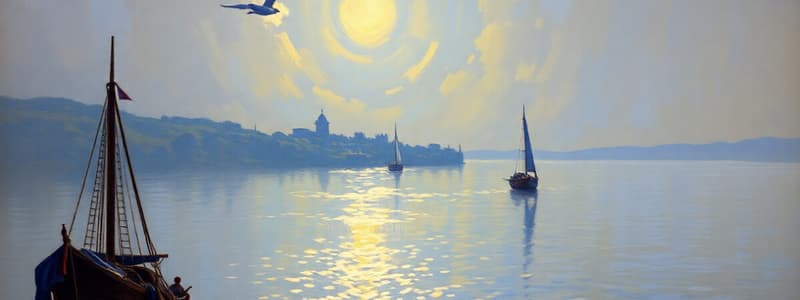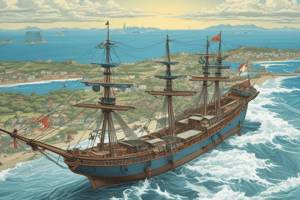Podcast
Questions and Answers
According to Article 34, the legal status of waters forming straits used for international navigation, the regime of passage shall not affect the legal status of the waters forming such straits or the exercise by the States bordering the straits of their ______ or jurisdiction.
According to Article 34, the legal status of waters forming straits used for international navigation, the regime of passage shall not affect the legal status of the waters forming such straits or the exercise by the States bordering the straits of their ______ or jurisdiction.
sovereignty
Article 35 indicates that nothing in Part III affects areas of internal waters within a strait, except where a straight baseline has the effect of enclosing as ______ waters.
Article 35 indicates that nothing in Part III affects areas of internal waters within a strait, except where a straight baseline has the effect of enclosing as ______ waters.
internal
According to Article 36, Part III doesn't apply to straits used for international navigation if there's a route through the high seas or an exclusive economic zone of similar ______ with respect to navigational and hydrographical characteristics.
According to Article 36, Part III doesn't apply to straits used for international navigation if there's a route through the high seas or an exclusive economic zone of similar ______ with respect to navigational and hydrographical characteristics.
convenience
Article 37 states that this section applies to straits used for international navigation between one part of the high seas or an exclusive economic zone and another part of the high seas or an exclusive ______ zone.
Article 37 states that this section applies to straits used for international navigation between one part of the high seas or an exclusive economic zone and another part of the high seas or an exclusive ______ zone.
Article 38 affirms that in straits meeting the criteria of article 37, all ships and aircraft enjoy the right of ______ passage, which shall not be impeded.
Article 38 affirms that in straits meeting the criteria of article 37, all ships and aircraft enjoy the right of ______ passage, which shall not be impeded.
According to Article 38, transit passage means the exercise of the freedom of navigation and overflight solely for continuous and ______ transit of the strait.
According to Article 38, transit passage means the exercise of the freedom of navigation and overflight solely for continuous and ______ transit of the strait.
Article 39 states that ships and aircraft exercising the right of transit passage must proceed without ______ through or over the strait.
Article 39 states that ships and aircraft exercising the right of transit passage must proceed without ______ through or over the strait.
Ships and aircraft in transit passage must refrain from any threat or use of force against the sovereignty, territorial integrity, or political ______ of States bordering the strait.
Ships and aircraft in transit passage must refrain from any threat or use of force against the sovereignty, territorial integrity, or political ______ of States bordering the strait.
In accordance with Article 40, during transit passage, foreign ships may not carry out research or survey activities without the prior authorization of the States ______ straits.
In accordance with Article 40, during transit passage, foreign ships may not carry out research or survey activities without the prior authorization of the States ______ straits.
Article 41 indicates that states bordering straits may designate sea lanes and prescribe traffic ______ schemes for navigation in straits where necessary to promote the safe passage of ships.
Article 41 indicates that states bordering straits may designate sea lanes and prescribe traffic ______ schemes for navigation in straits where necessary to promote the safe passage of ships.
States bordering straits may substitute other sea lanes or traffic separation schemes for previously designated ones, provided they give due ______.
States bordering straits may substitute other sea lanes or traffic separation schemes for previously designated ones, provided they give due ______.
According to Article 42, states bordering straits may adopt laws and regulations relating to transit passage through straits, concerning the safety of ______ and the regulation of maritime traffic.
According to Article 42, states bordering straits may adopt laws and regulations relating to transit passage through straits, concerning the safety of ______ and the regulation of maritime traffic.
User States and States bordering a strait should cooperate in the establishment and maintenance of necessary ______ and safety aids in a strait.
User States and States bordering a strait should cooperate in the establishment and maintenance of necessary ______ and safety aids in a strait.
States bordering straits shall not hamper transit passage and shall give appropriate publicity to any danger to ______ within or over the strait.
States bordering straits shall not hamper transit passage and shall give appropriate publicity to any danger to ______ within or over the strait.
Article 45 says the regime of innocent passage applies in straits either excluded from the application of transit passage or located between the high seas and the ______ sea of a foreign State.
Article 45 says the regime of innocent passage applies in straits either excluded from the application of transit passage or located between the high seas and the ______ sea of a foreign State.
According to Article 46, an "______ State" means a State constituted wholly by one or more archipelagos and may include other islands.
According to Article 46, an "______ State" means a State constituted wholly by one or more archipelagos and may include other islands.
Article 47 provides that an archipelagic State may draw straight archipelagic ______ joining the outermost points of the outermost islands provided that within such baselines are included the main islands.
Article 47 provides that an archipelagic State may draw straight archipelagic ______ joining the outermost points of the outermost islands provided that within such baselines are included the main islands.
The sovereignty of an archipelagic State extends to the waters enclosed by the archipelagic baselines, regardless of their ______ or distance from the coast.
The sovereignty of an archipelagic State extends to the waters enclosed by the archipelagic baselines, regardless of their ______ or distance from the coast.
Article 51 states that an archipelagic State shall respect existing agreements with other States and shall recognize traditional ______ rights of the immediately adjacent neighboring States.
Article 51 states that an archipelagic State shall respect existing agreements with other States and shall recognize traditional ______ rights of the immediately adjacent neighboring States.
According to Article 53, an archipelagic State may designate sea lanes and air routes suitable for the continuous and expeditious passage of foreign ships through its archipelagic waters and the adjacent ______ sea.
According to Article 53, an archipelagic State may designate sea lanes and air routes suitable for the continuous and expeditious passage of foreign ships through its archipelagic waters and the adjacent ______ sea.
Flashcards
Legal status of straits
Legal status of straits
International navigation straits are not affected in legal status by passage regimes.
Scope of Transit Passage
Scope of Transit Passage
Applies to straits used for international navigation between high seas/exclusive economic zones.
Transit Passage
Transit Passage
The right of continuous and expeditious transit between high seas or exclusive economic zones.
Duties During Transit
Duties During Transit
Signup and view all the flashcards
Sea Lanes
Sea Lanes
Signup and view all the flashcards
Strait regulations
Strait regulations
Signup and view all the flashcards
Strait Cooperation
Strait Cooperation
Signup and view all the flashcards
Duties of states bordering straits
Duties of states bordering straits
Signup and view all the flashcards
Innocent passage
Innocent passage
Signup and view all the flashcards
Archipelagic state
Archipelagic state
Signup and view all the flashcards
Archipelago
Archipelago
Signup and view all the flashcards
Archipelagic Baselines
Archipelagic Baselines
Signup and view all the flashcards
Archipelagic Sovereignty
Archipelagic Sovereignty
Signup and view all the flashcards
Archipelagic agreements
Archipelagic agreements
Signup and view all the flashcards
Sea Lanes Passage
Sea Lanes Passage
Signup and view all the flashcards
Archipelagic Passage
Archipelagic Passage
Signup and view all the flashcards
Archipelagic Waters
Archipelagic Waters
Signup and view all the flashcards
Archipelagic designation
Archipelagic designation
Signup and view all the flashcards
Related articles
Related articles
Signup and view all the flashcards
Study Notes
Straits Used for International Navigation
- Passage through straits should not affect the legal status of the waters or the sovereignty/jurisdiction of bordering states.
- States bordering straits exercise sovereignty/jurisdiction subject to international law.
Scope of Part III
- Part III does not affect internal waters within a strait, except where straight baselines enclose waters not previously considered internal.
- It also does not affect the legal status of waters beyond territorial seas as exclusive economic zones or high seas.
- The legal regime in straits regulated by long-standing specific international conventions remains unaffected.
High Seas/Exclusive Economic Zone Routes
- When there's a route through high seas or an exclusive economic zone of similar convenience, Part III doesn't apply to straits used for international navigation.
- For these routes, relevant parts of the Convention, including freedoms of navigation and overflight, apply.
Transit Passage Scope
- This section applies to straits used for international navigation between one part of the high seas or an exclusive economic zone and another of either.
Right of Transit Passage
- All ships and aircraft have the unimpeded right of transit passage in straits referenced in Article 37.
- Exception: transit passage doesn't apply if a strait is formed by an island of a bordering State and its mainland, and a high seas/exclusive economic zone route of similar convenience exists seaward of the island.
- Transit passage is for continuous and expeditious transit of the strait between high seas/exclusive economic zones.
- Entering, leaving, or returning from a State bordering the strait is allowed, subject to entry conditions.
- Activities not related to transit passage remain subject to the Convention's provisions.
Duties During Transit Passage
- Ships and aircraft must proceed without delay through/over the strait.
- Refrain from any threat/use of force against bordering States' sovereignty, integrity, or independence.
- Refrain from activities not part of normal transit, unless due to force majeure or distress.
- Compliance with the Part's provisions is mandatory.
- Ships must comply with international safety and pollution regulations, procedures, and practices.
- Aircraft must observe ICAO (International Civil Aviation Organization) rules and safety measures, and monitor designated radio frequencies.
Research & Survey Restrictions
- Foreign ships, including research vessels, need prior authorization from bordering States to conduct research or surveys.
Sea Lanes and Traffic Separation
- States bordering straits can designate sea lanes and traffic separation schemes for safe passage.
- They can substitute these lanes/schemes, giving due publicity.
- Sea lanes/traffic separation schemes must conform to international regulations.
- Proposals must be referred to an international organization for adoption after States bordering straits agree.
- Cooperation among concerned States is required for straits with lanes/schemes through multiple States' waters.
- States must clearly indicate sea lanes/schemes on charts.
- Ships in transit passage must respect these established sea lanes/schemes.
Laws of States Bordering Straits
- States may adopt laws/regulations regarding navigation safety, maritime traffic, pollution control relating to oil, oily waste and noxious substances, fishing (including gear stowage), and customs/fiscal/immigration/sanitary regulations,
- Regulations must not discriminate against foreign ships or impair transit passage rights.
- States must publicize these laws/regulations.
- Foreign ships must comply with applicable laws and regulations.
- Flag States are internationally responsible for losses or damage resulting from violations of these regulations by ships or aircraft with sovereign immunity.
Navigation, Safety, and Pollution Cooperation
- User States and States bordering straits should cooperate to establish and maintain navigational aids and prevent/control pollution.
Duties of States
- States bordering straits must not obstruct transit passage.
- They must publicize any navigation or air passage dangers
- No transit passage suspension
Innocent Passage
- The regime of innocent passage (Part II, section 3) applies in straits used for international navigation under specific conditions.
- It applies when transit passage is excluded under article 38, paragraph 1, or between a part of the high seas/exclusive economic zone and the territorial sea of a foreign State.
- Innocent passage through such straits cannot be suspended.
Archipelagic States
- "Archipelagic State" means a State made up of one or more archipelagos, possibly including other islands.
- "Archipelago" means a group of islands and natural features so closely related they form an intrinsic geographic, economic, and political entity.
Archipelagic Baselines
- An archipelagic State can draw straight baselines connecting the outermost points of the outermost islands and reefs.
- Within the baselines the ratio of water area to land area must be between 1:1 and 9:1
- Baseline lengths cannot exceed 100 nautical miles, although 3% can extend up to 125 nautical miles.
- Baselines should not deviate significantly from the archipelago's general configuration.
- Baselines cannot be drawn to/from low-tide elevations unless lighthouses/similar installations exist or the elevation is within the breadth of the territorial sea of the nearest island.
- The baseline system must not cut off another State's territorial sea from the high seas.
- Neighboring States' existing rights and legitimate interests in archipelagic waters must be respected.
- In calculating the water-to-land ratio, land areas can include waters within fringing reefs or enclosed oceanic plateaus.
- Baselines must be shown on adequate-scale charts, or geographical coordinates can be substituted.
- The archipelagic State must publicize charts/coordinates and deposit copies with the UN Secretary-General.
Territorial Sea and Economic Zone Breadth
- The breadth of the territorial sea, contiguous zone, exclusive economic zone, and continental shelf are measured from archipelagic baselines.
Legal Status of Waters, Airspace, Bed, and Subsoil
- Archipelagic State sovereignty extends to waters enclosed by Article 47 baselines, known as archipelagic waters, regardless of depth or distance from the coast.
- This sovereignty extends to the airspace, bed, subsoil, and resources within those archipelagic waters.
- Archipelagic sea lanes passage shall not affect the status of the archipelagic waters.
Delimitation of Internal Waters
- Archipelagic States may draw closing lines for delimiting internal waters per articles 9, 10, and 11.
Agreements, Fishing Rights, Submarine Cables
- Archipelagic States must respect existing agreements with other States.
- Recognize traditional fishing rights and legitimate activities of adjacent neighboring States.
- The relevant States can regulate these rights/activities through bilateral agreements.
- These rights can't be transferred/shared with third parties or their nationals.
- Archipelagic States must respect and allow maintenance/replacement of existing submarine cables, after proper notice.
Right of Innocent Passage
- All States' ships have the right of innocent passage through archipelagic waters with accordance to the Section 3 of Part II
- Archipelagic States can temporarily suspend innocent passage in specific areas where essential to their security, following due publication.
Archipelagic Sea Lanes Passage
- Archipelagic States can designate sea lanes and air routes suitable for continuous/expeditious passage of foreign ships/aircraft through archipelagic waters and adjacent territorial sea.
- All ships/aircraft enjoy the right of archipelagic sea lanes passage in designated lanes/routes.
- Archipelagic sea lanes passage means exercising navigation/overflight rights solely for continuous, expeditious, and unobstructed transit between parts of the high seas or exclusive economic zones.
- Sea lanes/air routes must traverse archipelagic waters and include normal passage routes used for international navigation.
- Ships/aircraft can’t deviate more than 25 nautical miles from axis lines during passage.
- Cannot navigate closer than 10% of the distance between the nearest points on islands bordering the sea lanes.
- Archipelagic States can prescribe traffic separation schemes in narrow channels within sea lanes.
- The State can substitute sea lanes/traffic separation schemes, after providing public notice.
- Sea lanes/traffic schemes must conform to international regulations.
- Proposals must be referred to a competent international organization for adoption after agreement with the archipelagic state.
- The State must clearly indicate sea lanes and traffic schemes on charts.
- Ships engaged in archipelagic sea lanes passage will respect established sea lanes and traffic schemes.
- If sea lanes or air routes have not been designated, the right of archipelagic sea lanes passage can transpire through routes normally use by the international community.
- Articles 39, 40, 42, and 44 apply mutatis mutandis to archipelagic sea lanes passage.
Studying That Suits You
Use AI to generate personalized quizzes and flashcards to suit your learning preferences.




